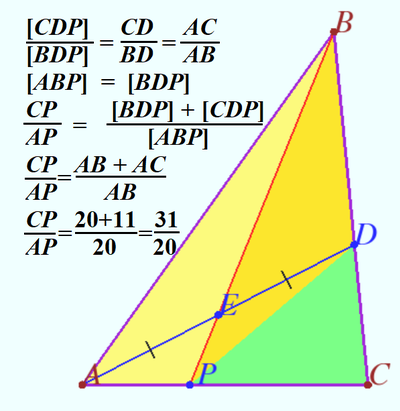Difference between revisions of "2011 AIME II Problems/Problem 4"
m (→Solution 1) |
(→Solution 6 (quick Menelaus)) |
||
| Line 34: | Line 34: | ||
<cmath>\frac{AD}{DM}\cdot\frac{MB}{BP}\cdot\frac{PC}{CA}=1\implies \frac{PC}{CA}=\frac{31}{51}.</cmath> | <cmath>\frac{AD}{DM}\cdot\frac{MB}{BP}\cdot\frac{PC}{CA}=1\implies \frac{PC}{CA}=\frac{31}{51}.</cmath> | ||
Therefore, <math>\frac{PC}{AP}=\frac{31}{51-31}=\frac{31}{20}.</math> The answer is <math>\boxed{051}</math>. -brainiacmaniac31 | Therefore, <math>\frac{PC}{AP}=\frac{31}{51-31}=\frac{31}{20}.</math> The answer is <math>\boxed{051}</math>. -brainiacmaniac31 | ||
| + | |||
| + | ==Solution 7 (Visual)== | ||
| + | [[File:2011 AIME II 4.png|400px]] | ||
| + | '''vladimir.shelomovskii@gmail.com, vvsss''' | ||
== See also == | == See also == | ||
Revision as of 12:26, 9 September 2022
Problem 4
In triangle ![]() ,
, ![]() and
and ![]() . The angle bisector of
. The angle bisector of ![]() intersects
intersects ![]() at point
at point ![]() , and point
, and point ![]() is the midpoint of
is the midpoint of ![]() . Let
. Let ![]() be the point of the intersection of
be the point of the intersection of ![]() and
and ![]() . The ratio of
. The ratio of ![]() to
to ![]() can be expressed in the form
can be expressed in the form ![]() , where
, where ![]() and
and ![]() are relatively prime positive integers. Find
are relatively prime positive integers. Find ![]() .
.
Contents
[hide]Solutions
Solution 1
![[asy] pointpen = black; pathpen = linewidth(0.7); pair A = (0,0), C= (11,0), B=IP(CR(A,20),CR(C,18)), D = IP(B--C,CR(B,20/31*abs(B-C))), M = (A+D)/2, P = IP(M--2*M-B, A--C), D2 = IP(D--D+P-B, A--C); D(MP("A",D(A))--MP("B",D(B),N)--MP("C",D(C))--cycle); D(A--MP("D",D(D),NE)--MP("D'",D(D2))); D(B--MP("P",D(P))); D(MP("M",M,NW)); MP("20",(B+D)/2,ENE); MP("11",(C+D)/2,ENE); [/asy]](http://latex.artofproblemsolving.com/a/7/a/a7abafb670ee1184b15212c26ace11aa21637220.png) Let
Let ![]() be on
be on ![]() such that
such that ![]() . It follows that
. It follows that ![]() , so
, so ![]() by the Angle Bisector Theorem. Similarly, we see by the Midline Theorem that
by the Angle Bisector Theorem. Similarly, we see by the Midline Theorem that ![]() . Thus,
. Thus, ![]() and
and ![]() .
.
Solution 2 (mass points)
Assign mass points as follows: by Angle-Bisector Theorem, ![]() , so we assign
, so we assign ![]() . Since
. Since ![]() , then
, then ![]() , and
, and ![]() , so
, so ![]() .
.
Solution 3
By Menelaus' Theorem on ![]() with transversal
with transversal ![]() ,
, ![\[1 = \frac{CP}{PA} \cdot \frac{AM}{MD} \cdot \frac{DB}{CB} = \frac{CP}{PA} \cdot \left(\frac{1}{1+\frac{AC}{AB}}\right) \quad \Longrightarrow \quad \frac{CP}{PA} = \frac{31}{20}.\]](http://latex.artofproblemsolving.com/6/f/a/6fa8a05c156abc5702313c8aade15cfe46e1aec3.png) So
So ![]() .
.
Solution 4
We will use barycentric coordinates. Let ![]() ,
, ![]() ,
, ![]() . By the Angle Bisector Theorem,
. By the Angle Bisector Theorem, ![]() . Since
. Since ![]() is the midpoint of
is the midpoint of ![]() ,
, ![]() . Therefore, the equation for line BM is
. Therefore, the equation for line BM is ![]() . Let
. Let ![]() . Using the equation for
. Using the equation for ![]() , we get
, we get ![]()
![]() Therefore,
Therefore, ![]() so the answer is
so the answer is ![]() .
.
Solution 5
Let ![]() . Then by the Angle Bisector Theorem,
. Then by the Angle Bisector Theorem, ![]() . By the Ratio Lemma, we have that
. By the Ratio Lemma, we have that ![]() Notice that
Notice that ![]() since their bases have the same length and they share a height. By the sin area formula, we have that
since their bases have the same length and they share a height. By the sin area formula, we have that ![]() Simplifying, we get that
Simplifying, we get that ![]() Plugging this into what we got from the Ratio Lemma, we have that
Plugging this into what we got from the Ratio Lemma, we have that ![]()
Solution 6 (quick Menelaus)
First, we will find ![]() . By Menelaus on
. By Menelaus on ![]() and the line
and the line ![]() , we have
, we have
![]() This implies that
This implies that ![]() . Then, by Menelaus on
. Then, by Menelaus on ![]() and line
and line ![]() , we have
, we have
![]() Therefore,
Therefore, ![]() The answer is
The answer is ![]() . -brainiacmaniac31
. -brainiacmaniac31
Solution 7 (Visual)
 vladimir.shelomovskii@gmail.com, vvsss
vladimir.shelomovskii@gmail.com, vvsss
See also
| 2011 AIME II (Problems • Answer Key • Resources) | ||
| Preceded by Problem 3 |
Followed by Problem 5 | |
| 1 • 2 • 3 • 4 • 5 • 6 • 7 • 8 • 9 • 10 • 11 • 12 • 13 • 14 • 15 | ||
| All AIME Problems and Solutions | ||
The problems on this page are copyrighted by the Mathematical Association of America's American Mathematics Competitions. ![]()









